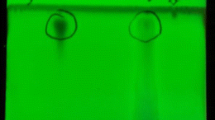Abstract
Securinega virosa (Roxb ex. Willd) Baill. is a plant which is commonly used in African traditional medicine in management of mental illness. Previous study showed that the crude methanolic root bark extract of the plant possesses antipsychotic activity. In this study, the antipsychotic potential of the residual aqueous fraction of the plant was evaluated using two experimental models, apomorphine induced stereotypic climbing behaviour and swim induced grooming, all in mice. The effect of the fraction on haloperidol-induced catalepsy was also evaluated. The fraction significantly reduced the mean climbing score at the highest dose tested (500 mg/kg). In the swim-induced grooming test, the fraction significantly and dose-dependently (125–500 mg/kg) decreased the mean number and mean duration of swim-induced grooming activity in mice. Similarly, the standard haloperidol (1 mg/kg) significantly (p < 0.001) decreased the mean grooming episodes and duration. However, the fraction did not significantly potentiate haloperidol-induced catalepsy. These results suggest that the residual aqueous fraction of methanol root bark extract of Securinega virosa contains biological active principle with antipsychotic potential.


Similar content being viewed by others
References
Chesher GB, Jackson DM (1981) Swim-induced grooming in mice is mediated by a dopaminergic substrate. J Neural Transm 50(1):47–55. doi:10.1007/bf01254913
Costall B, Fortune DH, Naylor RJ, Marsden CD, Pycock CJ (1975) Serotonergic involvement with neuroleptic catalepsy. Neuropharmacol 14:859–868. doi:10.1016/0028-3908(75)90114-8
Costall B, Naylor RJ, Nohria V (1978) Climbing behavior-induced by apomorphine in mice: a potent model for the detection of neuroleptic activity. Eur J Pharmacol 50:39–50
Dalziel JM (1936) The useful plants of West Tropical Africa. Watmonghs, Idle, London, pp 354–355
Ehmann T, Yager J, Hanson L (2004) Early psychosis: a review of the treatment literature. Child Ment Health Pol Res Prog 7:1–52
Farde L, Nordstrom AL, Wiesel FA, Pauli S, Halldin C, Sedvall G (1992) PET-analysis of central D-2 and D2-dopamine receptor occupancy in patients treated with classical neuroleptics and clozapine: relation to extrapyramidal side effects. Arch Gen Psychiatry 49:538–544
Hoffman DC, Donovan H (1995) Catalepsy as a rodent model for detecting antipsychotic drugs with extrapyramidal side effect liability. Psychopharmacology 120:128–133. doi:10.1007/BF02246184
Ingale SP, Kasture SB (2012) Psychopharmacological profile of Passiflora incarnata linn in mice. Int J Phytopharmacol 3(3):263–268
Kedves R, Saghy K, Gyertyan I (2008) Comparison of the effects of antipsychotic drugs in two antipsychotic screening assays: Swim-induced grooming and apomorphine-induced climbing test in mice. In: Ballintijn MR, Bogers ND, Grieco F, Loijen LWS, Noldus LPJJ, Smit G, Zimmerman PH (eds) Proceedings of Measuring behavior Spink AJ. Maastricht, The Netherlands, August, pp 26–29
Magaji MG, Anuka JA, Abdu-Aguye I, Yaro AH, Hussaini IM (2008) Behavioural effects of the methanolic root bark extract of Securinega virosa in rodents. Afr J tradit Complement Altern Med 5(2):147–153
Magaji MG, Yaro AH, Musa AM, Anuka JA, Abdu-Aguye I, Hussaini IM (2011) Sedative activity of residual aqueous fraction of Securinega virosa (Roxb. ex Willd) Baill. Root bark extract in mice. Niger J Pharm Sci 10(2):34–44
Moore NA, Axton MS (1988) Production of climbing behaviour in mice requires both D1 and D2 receptors activation. Psychopharmacology 94:261–269
Nair V, Arjuman A, Dorababu P, Gopalakrishna U, Rao C, Mohan L (2007) Effect of NR-ANX-C (a polyherbal formulation) on haloperidol induced catalepsy in albino mice. Indian J Med Res 126:480–484
National Research Council Guide for the Care and Use of Laboratory Animals (1996) Guide for the care and use of Laboratory Animals. A report of the Institute of Laboratory Animal Resource Committee on the care and use of laboratory animals. NIH publication no. 85–23. U.S. Department of Health and Human Services, Washington, DC
Neuwinger JD (translated from the German by Porter A) (1996) African ethnobotany-poisons and drugs. Chapman and Hall, Weinheim. Germany. pp. 495–499
Salam OA, Nada S (2011) Piracetam reverses haloperidol-induced catalepsy in mice. Turk J Med Sci 41(4):693–699
Author information
Authors and Affiliations
Corresponding author
Rights and permissions
About this article
Cite this article
Magaji, M.G., Mohammed, M., Magaji, R.A. et al. Evaluation of the antipsychotic potential of aqueous fraction of Securinega virosa root bark extract in mice. Metab Brain Dis 29, 161–165 (2014). https://doi.org/10.1007/s11011-014-9483-x
Received:
Accepted:
Published:
Issue Date:
DOI: https://doi.org/10.1007/s11011-014-9483-x




